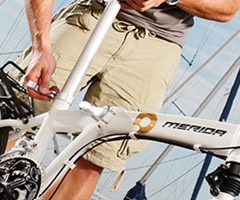Bicycle disc brake
The disc brake is composed of a brake disc connected to the wheel and a brake caliper on the edge of the disc. When braking, the high-pressure brake fluid pushes the brake pads to clamp the brake disc to produce a braking effect.
Disc brakes are sometimes called disc brakes. They are divided into ordinary disc brakes and ventilated disc brakes. Ventilated disc brakes have many circular vents drilled on the disc surface, or cut vent slots on the end of the disc or prefabricated rectangular vents. Ventilated disc brakes use the effect of air flow, and their cooling and heating effects are better than ordinary disc brakes. The main advantage of disc brakes is that they can brake quickly when braking at high speeds. The heat dissipation effect is better than that of drum brakes. The braking efficiency is good and it is easy to install advanced electronic equipment like ABS. Using metal blocks (discs) instead of drums, there are flat brake shoes on both sides of the brake discs. When the hydraulic pressure from the brake master cylinder is sent to the sub-cylinders, the brake shoes are clamped to the brake discs to achieve tight braking. The effect is now widely used on the front wheels. Some high-end cars are equipped with four-wheel disc brakes. The advantages are sensitive action, good heat dissipation, no need to adjust the brake gap, and easy maintenance.









































